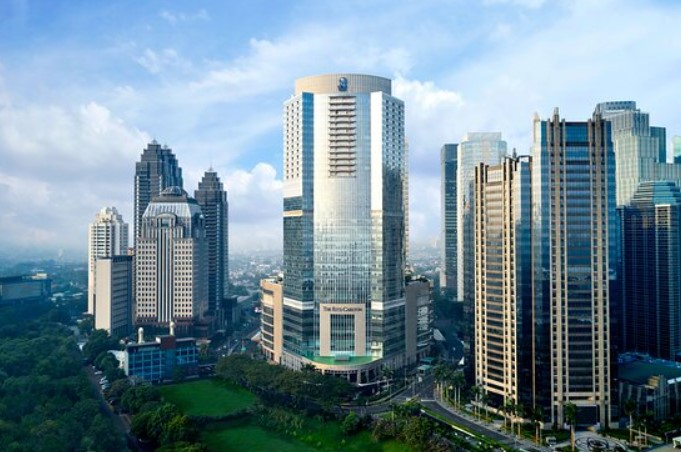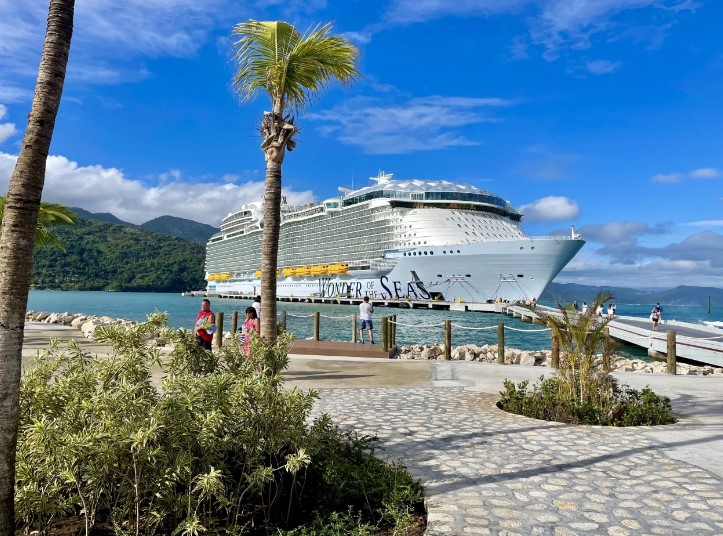They may not be as punctual as Japan’s famed bullet trains – but they are no less iconic. They are swooned over during picnics. They are painstakingly painted. They are obsessed over in poems. They are cited as a symbol of the transient nature of life. And they are diligently sprinkled on Starbucks lattes.
For centuries, springtime in Japan has long been synonymous with one (very pink) thing: its sakura cherry blossoms – plus the nation’s near spiritual appreciation of the delicate pink blooms.
It’s pretty much impossible to think of spring in Japan without an image of a sea of cherry trees awash with perfect pink blooms instantly coming to mind – be it surrounded by Tokyo’s cloud-brushing concrete skyscrapers, in the foreground of the looming triangular form of Mount Fuji or on the forest-wrapped grounds of a remote mountainside temple.
Every year, under the meticulous gaze of armies of official sakura forecasters, the small buds burst into flowers on trees across the archipelago, starting in Okinawa on the southern tip, before sweeping slowly north across the country and finishing in Hokkaido.
And this year’s pending springtime sakura frenzy is perhaps more special than ever: it is the first cherry blossom season in Japan open to overseas visitors in four years, due to the nation shutting down its borders due to the pandemic.
For the first time in four years, foreign visitors will be able to witness the sakura
Credit: Getty
Adding an extra layer of post-pandemic poignancy is the rich symbolism of the flowers. Their short-lived existence taps into a long-held appreciation of the beauty of the fleeting nature of life, as echoed across the nation’s cultural heritage, from tea ceremonies to wabi sabi ceramics.
The blossoms also, quite literally, symbolise new beginnings, with April 1 being the first day of both the financial and academic year in Japan. In a nutshell? The cherry blossoms are not just pretty pink flowers: they are the floral embodiment of Japan’s most deep-rooted cultural and philosophical beliefs.
Like many things in Japan, its cherry blossoms – and the nation’s unwavering passion for them – smoothly tap into both the ancient and the modern. From as early as the eighth century, elite imperial courtiers paused to appreciate the delicate pink cherry blossoms known as sakura before indulging in picnics and poetry sessions beneath the blooms.
‘Catching a glimpse of Japan’s iconic pink flowers – and the richly layered culture that goes hand in hand with them – is a once-in-a-lifetime experience’
Fast-forward more than a millennium and the flowers that launched a thousand haiku are no less revered in modern-day Japan, with the fevered countdown to sakura season seeping into countless elements of daily life. The moment Valentine’s Day chocolates are cleared from supermarket, conbini and department store displays, the all-pink retail revolution begins: plastic cherry blossom flowers and countless sakura-flavoured treats appear on shop shelves (from cherry-blossom-and-butter crisps and sakura mochi rice cakes to cherry blossom Pepsi).
The countdown excitement is heightened further by the televised Cherry Blossom Forecast which offers a petal-by-petal analysis of the advance of the blooms – known as the cherry blossom front – as they sweep from the south to the north of the archipelago.
When the blooms actually arrive (as confirmed by teams of meticulous cherry blossom officials), it is time to indulge in one of the nation’s all-time favourite pastimes – hanami, which literally translates as “looking as flowers” and refers to flower appreciation picnics under the blooms.
This involves a microcosm of society – from salarymen and students to housewives and grannies – gathering on tarpaulin in parks and nature spots across the country to indulge in hanami picnics (some civilised, some surprisingly drunken).
.jpg?imwidth=350)
A picnic beneath the cherry trees is a must
Credit: Getty
Fortunately for those planning a trip, the task of forecasting the exact arrival of the cherry blossoms is taken very seriously in Japan. Since 1951, teams of meteorologists have been dispatched to monitor the advance of the cherry blossom front – sakura zensen in Japanese – as they burst into bloom.
Today, it is a hi-tech affair, with forecasts and scientists undertaking complicated mathematical equations filling television screens in the build-up to their appearance. Officials traditionally observe the pale pink blooms of the yoshino cherry tree – Japan’s most common type – with the season declared open when at least five or six flowers have opened on a sample tree in any given area. The flowers bloom for around a week before the so-called “sakura snow” effect starts and they float sadly off the trees.
It’s worth bearing in mind that the dates can fluctuate – some years, they are early, following a spell of warm weather, while in other years, chiller temperatures delay their arrival or downpours cut short flowering.
But the first blossoms generally appear in Okinawa in January and slowly move up the archipelago, passing through Japan’s central islands (including Tokyo and Kyoto) in late March and early April, before progressing further north and hitting Hokkaido in early May.
As a result, generally speaking, it’s a safe bet to book a trip to cover the last week of March and the first week of April, for those keen to catch the blooms in Tokyo or Kyoto, plus many other spots. (This year, in Tokyo, blossoms are likely to appear March 21, peaking around March 29, while Kyoto will start around March 27, peaking April 4, according to current forecasts.)
The capital is always a good starting point. Despite the concrete and skyscrapers – or maybe because of the omnipresence of the man-made over nature in the sprawling megalopolis – Tokyoites are evangelical in their enthusiasm of all things sakura. This is reflected in the packed parks and riverside spots – often with the so-called sakura police having to herd crowds and guide queues in the busiest locations.
Sakura watchers in Nakameguro
Credit: Getty
Luckily for city-dwellers, many parks are carefully choreographed with clusters of cherry trees, precisely for this purpose. Highlights include Ueno Park, one of Japan’s oldest and most famous public spaces (also home to a string of top museums, shrines and ponds), which attracts epic-sized crowds to admire its 1,000-plus blooming cherry trees. A more sedate alternative is Shinjuku Gyoen, a surprisingly serene and beautifully maintained park a short walk from the neon blare of Shinjuku, with 1,500 cherry trees and expanses of lawn (entry costs Y200/£1.25 for adults, Y50 for children).
‘From bustling picnics in inner-city parks to meditative moments in mountainside temples, a visit timed to coincide with cherry blossom season promises to be haiku-inspiringly beautiful’
Another cult spot is Nakameguro, a creative neighbourhood south of Shibuya, with a cherry-tree-lined canal: perfect for an evening stroll, the trees are lit up with lanterns after dark while the canalside roads bustle with food and drinks stalls. (It’s worth noting it’s insanely busy at peak time: try to visit either early morning or late at night, ideally on a week day, to avoid large crowds).
Meanwhile, the atmospheric eastern neighbourhood Yanaka – all narrow lanes and old wooden houses with tiny restaurants and young craftsmen setting up shop – is worth a visit for its cherry tree-filled cemetery.

A happy couple in Shinjuku Gyoen National Garden
Credit: Getty
The south
It all starts at the bottom – more precisely, the far-flung southernmost subtropical islands of Okinawa, home to Japan’s first cherry blossoms. The blooms – often bell-shaped and a deeper pink than other regions – arrive in mid-January, with viewing spots including the wild forested Yanbaru area in the north of the main Okinawa island.
The ruins of Nakijin castle are another highlight, with a famed tunnel of cherry trees illuminated with lanterns in the grounds of the Unesco World Heritage site every night during its sakura season.
Next up is Kyushu, Japan’s third biggest island (located above Okinawa and fringed by the Pacific), famed for its warm climate, hot spring onsen baths, volcanoes and delicious cuisine. Kumamoto is a popular spot, with its tiered castle creating an image as pretty as a woodblock print when its 1,000-plus cherry trees bloom.
Cherry blossom in Kumamoto
Credit: Getty
For the perfect overlap of sakura and onsen, check into Hoshino Resort Kai Yufuin, a sleek new Kengo Kuma-designed hotel scattered around tiered jewel-green rice fields, with contemporary outdoor baths offering cherry blossom views.
The former ancient capital is perhaps the ultimate venue for cherry blossom appreciation – and it’s also one of the busiest. Those prepared to brave the heaving, still-masked post-pandemic crowds are spoilt for choice. The best flower spots include Maruyama Park, packed with hanami picnickers from day to night, the Kamo River, lined with large cherry trees, the bloom-filled Imperial Palace Park, and the Philosopher’s Path, which runs alongside a cherry tree-lined canal, leading to a string of hidden temples and shrines.
For a more luxurious – and secluded – taste of Kyoto’s cherry blossoms, consider checking into Aman Kyoto, where the painterly pink blooms can be found in the exquisite hidden gardens that form the heart of the escape.
.jpg?imwidth=350)
Kyoto is the ultimate cherry blossom location
Credit: Getty
Honshu
One lesser-known beauty spot is Gifu, a mountainous prefecture on the central island of Honshu, which is home to the famed Takayama Spring Festival, when exquisitely ornate floats, handcrafted using centuries-old artisan techniques, are paraded across bridges, down lanes and past clusters of cherry trees throughout the city of Takayama.
Kinosaki Onsen, a hot spring resort in southwestern Hyogo prefecture, is another fine spot to combine bathing and blossoms. Check into a traditional ryokan and soak in onsen baths against a backdrop of picture-perfect cherry blossoms trees that line its streets and riverbanks.
Those keen to avoid the crowds would do well to travel later – and, following the flow of the cherry blossom front, head further north.
Hitome Senbonzakura in Miyagi prefecture offers an eye-catching vista of 1,000 cherry trees lining a river against the striking backdrop of snowcapped mountains.
See sakura against a backdrop of snowcapped mountains
Credit: Getty
Kakunodate is another cherry blossom gem, famed for its romantically weeping cherry trees, brought to the region from Kyoto hundreds of years ago by local samurai.
And the final hurrah of Japan’s cherry blossom celebrations can be found in Hokkaido, the northernmost island. The main city Sapporo is awash with cherry blossoms (Maruyama Park and Hokkaido-jingu shrine in particular) while the adventurous can squeeze in some skiing with sakura views. Sapporo Teine, the site of the 1972 Winter Olympics, is a short drive from the city and open to skiers until early May.
Niseko is a good spot to visit too; while it’s most famous for its buzzing (and stylish) skiing and snowboarding spots, its off-season beauty is perhaps one of Japan’s best kept secrets.
For many, Tokyo works as a good starting point. Fly into Tokyo Haneda if possible (rather than Narita) as it’s much closer to the city centre. Alternatively, for those keen to focus more on Kyoto and southern regions, fly into Kansai International Airport, just outside Osaka – a perfect springboard for exploring Kyoto, Kyushu and beyond.
Those keen to explore the cherry blossom trail beyond Tokyo should look into buying a Japan Rail Pass before they travel. They must be purchased outside Japan and collected upon arrival at the airport but offer massive savings on expensive bullet train rides, making it easy to travel between cherry blossom hotspots across the archipelago.
The famous Shinkansen bullet train
Credit: AFP
It is usually cheaper if you can book as far in advance as possible – spring is one of the busiest seasons across Japan, both for domestic and overseas visitors, with hotels often filling up early. That said, it’s also always worth speaking to tour operators for last-minute deals.
While it is easy to spend considerably more, between £3,000 and £4,000 per person should be sufficient for a memorable and comfortable trip. The biggest expense is likely to be the flights, with costs soaring compared to pre-pandemic levels, while average flight times have also increased to 13-plus hours due to the closure of Russian airspace. The cheapest non-direct (and very lengthy) flights are likely to hover £700; direct London to Tokyo flights can top £1,000. On the plus side, Japan’s weakened yen means lower on-the-ground costs, including hotel stays and restaurant meals.
Expect a cornucopia of adventurous sakura-tinged dishes, from sakura rice cakes to sakura petal beer. In addition, a whole raft of spring treats are also on offer in restaurants at this time of year, such as clams and bamboo shoots. Be adventurous!
Follow in the footsteps of tea masters and poets and get inspired by the cherry blossoms. A whole raft of books explore the world of sakura, including The Sound of Water, a selection of 200 haiku translated by Sam Hamill, including bite-sized poems by masters such as Basho, Isso and Buson, and Cherry Blossoms by James T Ulak and Howard S Kaplan, an illustrated hardback book devoted to cherry blossoms in Japanese art and culture, in all their pink glory.
Embrace the sakura spirit and put together your own DIY hanami picnic. Pick up food – ideally a seasonal bento box from a local supermarket or depachika (the basement food hall of a department store). Next, stop by a conbini for drinks, disposable cups and tarpaulin – and simply find a space beneath a blossoming tree.
Springtime can be chillier than expected. Stop by a conbini and pick up another indispensible hanami accessory – self-heating packs known as kairo which can be inserted into pockets or stuck onto clothes to warm you when when temperatures drop.
.jpg?imwidth=350)
Grazing in paradise
Credit: Getty
With English not so widely spoken outside big cities, particularly at smaller traditional hotels, plus online information at times limited to Japanese, trips here can be infinitely less stressful when booked through a tour operator. Many offer a spectrum of packages – from the uber-deluxe classic tours to the self-guided budget options.
Japan Journeys (www.japanjourneys.co.uk; 020 8064 2771); offers a classic cherry blossom trip costing £4,195 per person, including ten nights’ accommodation but excluding international flights. It involves a whirlwind of top cherry blossom spots – Kyoto, Hakone, Nara, Hiroshima, Miyajima, Mount Fuji and Tokyo – plus hot spring onsen bathing and a dinner with a maiko in Kyoto’s historic Gion district. March 27–April 7.
Recover from your sakura hunting with time in an onsen
Credit: Getty
Best of the north
Skip the crowds and head north with InsideJapan Tours (www.insidejapantours.com; 0117 244 3380), which offers a 13-night Northern Highlights trip, from £2,630 per person (excluding international flights). It explores the temples, sacred mountains and traditional inns (plus cherry blossom spots) of the scenic northeastern Tohoku region – perfect to schedule for late April when the sakura burst into bloom.
Mix cherry blossom and food appreciation in one trip, with Audley (www.audleytravel.com/japan; 01993 838210). Book a 14-day tailor-made trip tying in a string of food experiences across cherry blossom hubs – from sushi making in Tokyo, an evening food tour in Kanazawa and an izakaya cooking course plus market visit in Kyoto – as well as seasonal cuisine in Hakone and Tsumago. It costs from £5,395 per person (including flights and accommodation) for departures in March and April 2024.
Japanese cuisine needs little introduction
Credit: Getty
Getting creative
Black Tomato (www.blacktomato.com; 020 7426 9888) offers a springtime exploration of all things creative, with its Tokyo, Kyoto & Naoshima: Unique Customs & Timeless Traditions trip. It costs from £12,000 per person for 12 nights, including accommodation and a curated itinerary, exploring the worlds of sumo and samurai in Tokyo and Kyoto as well as contemporary art on Naoshima, an island in the Seto Inland Sea. International flights cost extra. The trip is offered between March and May – making it the perfect opportunity to explore against a cherry blossom backdrop.
Japan has long been labelled one of the world’s most expensive destinations, but with some careful planning, it’s possible to enjoy a springtime trip of a lifetime on a budget.
Key steps include booking flights as early as possible, buying a rail pass in advance and choosing accommodation carefully.
In Tokyo, a raft of new, more affordable hotels has opened since the Olympics (among them OMO5 Tokyo Otsuka). Outside cities, there are also countless smaller inns known as minshuku, which are often good value and offer an authentic experience.
Eating out at local restaurants is also surprisingly affordable. Many high-quality establishments offer unexpectedly good value multi-course set lunch menus from around 1,000 yen (£6.25).
Tour operators are also increasingly tapping into the budget market. A good option is InsideJapan Tours’ self-guided ‘7 Night Price Cruncher’ package, which taps into this excellent company’s impressive insider know-how and contacts – and costs just £1,020 per person (excluding international flights).
Masks – yes, these are still all the rage in Japan. Be prepared to see face coverings everywhere, while some establishments – museums, hotels, restaurants – also still insist on them being worn inside.
Comfortable shoes – visiting the cherry blossoms involves some commitment, particularly in nature spots. Be prepared to walk.
Warm clothing – despite the arrival of spring, it’s often still surprisingly cool at this time of year, particularly as the sun sets at a hanami picnic in the park.
Camera – there are few more photogenic trips than a cherry blossom tour of Japan.
It’s not necessary to arrange a visa before entering Japan, if visiting for a holiday of less than three months. While Covid rules change regularly, visitors who are triple vaccinated do not currently need to do a test upon arrival. All visitors are, however, encouraged to register their details and vaccination certificates online ahead of arriving, for a “fast track” entry system – which will considerably cut queuing time after landing (for more information, visit travelhealthpro.org.uk/country/114/japan and mofa.go.jp/ca/fna/page4e_001053.html). Another useful resource is British Embassy Tokyo on Twitter.
If you become ill while travelling, the Foreign Office has a list of English-speaking doctors and medical facilities.






More Stories
Exploring the “Otaku Island” of Enoshima
Japan eases travel with eVisas
Should you visit Japan or South Korea?